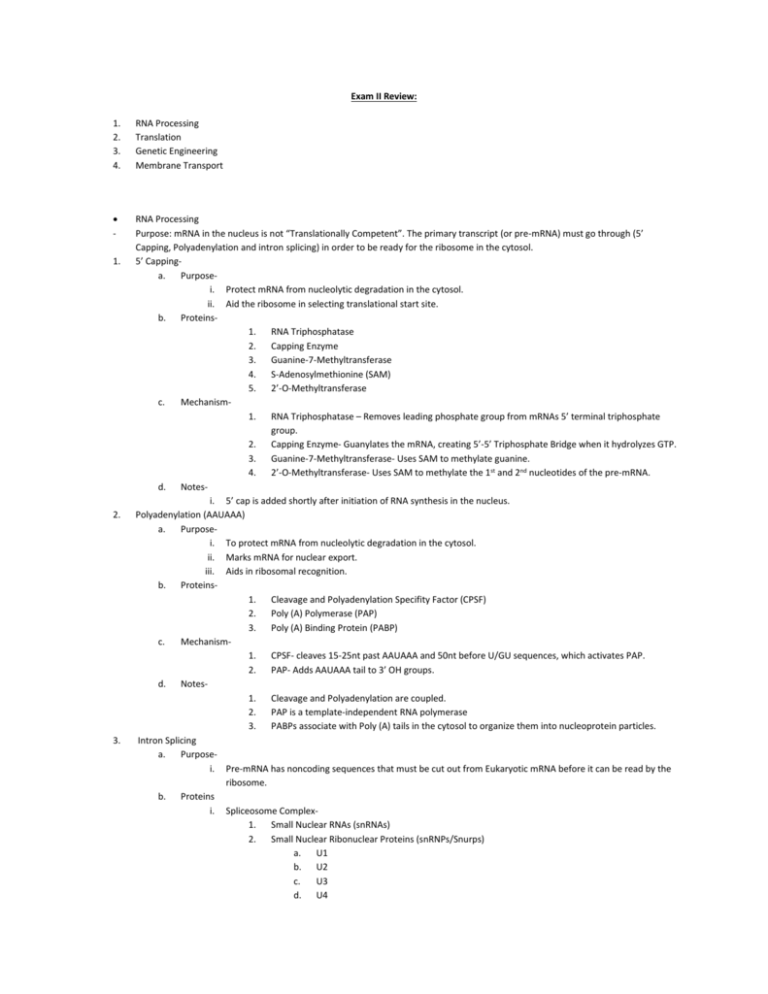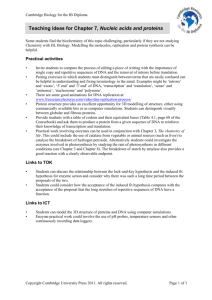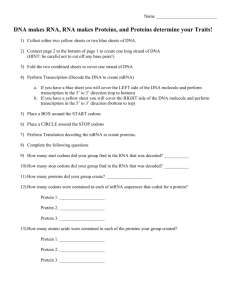Exam II review outline * Please print and bring with you!
advertisement

Exam II Review: 1. 2. 3. 4. RNA Processing Translation Genetic Engineering Membrane Transport - RNA Processing Purpose: mRNA in the nucleus is not “Translationally Competent”. The primary transcript (or pre-mRNA) must go through (5’ Capping, Polyadenylation and intron splicing) in order to be ready for the ribosome in the cytosol. 5’ Cappinga. Purposei. Protect mRNA from nucleolytic degradation in the cytosol. ii. Aid the ribosome in selecting translational start site. b. Proteins1. RNA Triphosphatase 2. Capping Enzyme 3. Guanine-7-Methyltransferase 4. S-Adenosylmethionine (SAM) 5. 2’-O-Methyltransferase c. Mechanism1. RNA Triphosphatase – Removes leading phosphate group from mRNAs 5’ terminal triphosphate group. 2. Capping Enzyme- Guanylates the mRNA, creating 5’-5’ Triphosphate Bridge when it hydrolyzes GTP. 3. Guanine-7-Methyltransferase- Uses SAM to methylate guanine. 4. 2’-O-Methyltransferase- Uses SAM to methylate the 1st and 2nd nucleotides of the pre-mRNA. d. Notesi. 5’ cap is added shortly after initiation of RNA synthesis in the nucleus. Polyadenylation (AAUAAA) a. Purposei. To protect mRNA from nucleolytic degradation in the cytosol. ii. Marks mRNA for nuclear export. iii. Aids in ribosomal recognition. b. Proteins1. Cleavage and Polyadenylation Specifity Factor (CPSF) 2. Poly (A) Polymerase (PAP) 3. Poly (A) Binding Protein (PABP) c. Mechanism1. CPSF- cleaves 15-25nt past AAUAAA and 50nt before U/GU sequences, which activates PAP. 2. PAP- Adds AAUAAA tail to 3’ OH groups. d. Notes1. Cleavage and Polyadenylation are coupled. 2. PAP is a template-independent RNA polymerase 3. PABPs associate with Poly (A) tails in the cytosol to organize them into nucleoprotein particles. Intron Splicing a. Purposei. Pre-mRNA has noncoding sequences that must be cut out from Eukaryotic mRNA before it can be read by the ribosome. b. Proteins i. Spliceosome Complex1. Small Nuclear RNAs (snRNAs) 2. Small Nuclear Ribonuclear Proteins (snRNPs/Snurps) a. U1 b. U2 c. U3 d. U4 1. 2. 3. e. f. c. Mechanism1. 2. d. - 1. U5 U6 Lariat Structure- U1 recognizes 5’ end of intron, U2 recognizes branch point adenine. A 2’, 5’ phosphodiester bond forms between introns adenosine residue, the exon is thereby released; while the intron forms a lariat structure. Splice Product- The 5’ exons free 3’ OH group displaces the 3’ end of the intron, forming a phosphodiester bond with the 5’ terminal phosphate of the 3’ exon, yielding the spliced product. The intronic lariat is released with its 3’ OH group and is rapidly recycled. Notes: TRANSLATION: Purpose: Ribosomes orchestrate translation of mRNA to synthesize proteins. Proteins1. Ribosome 2. tRNA 3. Aminoacyl-tRNA Synthase 4. IF-1 5. IF-2 6. IF-3 7. EF-Tu 8. EF-Ts 9. EF-G 10. RF-1 11. RF-2 12. RF-3 13. RRF 14. Ubiquitin 15. Proteosome 16. HSP 70 17. HSP 60 18. Chaperone Proteins Ribosomesa. Purpose i. Bind mRNAs such that its codons can be read with high fidelity. ii. Has specific binding sites for tRNA molecules iii. Mediation of interactions of nonribosomal protein factors that promote initiation, elongation and termination of polypeptide. iv. Catalyze peptide bond formation v. Moves to translate sequential codons b. Prokaryotic v. Eukaryotic i. Prokaryotic 1. Small subunit (30S)- 16S rRNA + 21 proteins 2. Large subunit (50S)- 5S and 23S rRNA + 31 proteins a. Proteins rich in K & R amino acid residues ii. Eukaryotic 1. Small subunit (40S)- 18S rRNA + 33 proteins 2. Large subunit (60S)- 28,5.8 and 5S rRNAs + 49 proteins a. More complex because euk. Translation is more complex. c. Structurei. Secondary- 4 domain flower ii. Tertiary-Numerous lobes, channels and tunnels iii. A site- Accommodates incoming aminoacyl-tRNAs iv. P site- Accommodates incoming peptidyl-tRNAs v. E site- Accommodates deacylated tRNA vi. Small subunit- vii. 2. 3. 4. tRNAs a. a. Purpose: Binding tRNAs and ribosomal recognition a. Purpose: Mediates chain elongation Large subunit Purpose: i. 3 base anticodon determines mRNA and amino acid binding. ii. When charged, amino acids bind to tRNA by ester bonds b. Structure i. Secondary- Cloverleaf 1. 5’ terminal phosphate group. 2. Acceptor Stem- Amino acid covalently attached to its 3’ terminal OH group. 3. D Arm- Dihydrouridine 4. Anticodon Arm- Contains anticodon sequence, 3’ purine is invariably modified. 5. T Arm- Psuedouridine 6. CCA Sequence- 3’ sequence with free OH group. 7. 15 invariant/8 variant positions- Only purine/pyrimidine. 8. Variable Arm- Base modifications help promote attachment of proper amino acid to the acceptor stem and strengthen codon-anticodon interactions. ii. Tertiary 1. L shape in which acceptor Stem/T Arm stems from one leg and D Arm/Anticodon Arm stems from the other. 2. Maintained by extensive stacking interactions and non-Watson-Crick associated base pairing between helical stems. c. Function- Charged tRNAs carry amino acids to the ribosome i. Mechanism 1. Aminoacyl-tRNA Synthetase- Produces the charged amino acid a. AA + ATP AA-AMP + Pyrophosphate (2Pi) b. AA-AMP AA-tRNA + AMP d. Notes i. AA-tRNA (Aminoacyl-adenylate) is a high energy compound) ii. The overall reaction is driven to completion by the hydrolysis of 2Pi generated in step a. Translation Mechanism: a. Initiation i. Binding to start codon (AUG/Met) ii. Small subunit finds Kozac sequence (ACCAUGG) (Shine-Dalgarno=prok. AGGAGG). 1. Proteins a. IF-1: Assists IF-3. b. IF-2: Binds to initiator tRNA start codon (AUG/Met) and GTP. c. IF-3: Releases mRNA and tRNA from subunit. b. Elongation i. Elongation factors bind all tRNAs except start codons. ii. Requires GTP iii. Peptide bonds catalyzed by peptidyl transferase activity of large subunit. iv. Polypeptides synthesizes about 40AA/second. 1. Proteins a. EF-Tu: Binds AA-tRNA to GTP at A-site. b. EF-Ts: Displaces GDP from EF-Tu. c. EF-G: Promotes translocation through GTP binding and hydrolysis. c. Termination i. Release factors mimic tRNAs and bind to stop codons. ii. Release factors use GTP to bind the protein to water, terminating the protein chain. 1. Proteins a. RF-1: Recognizes UAA + UAG stop codons. b. RF-2: Recognizes UAA + UGA stop codons. c. RF-3: Stimulates RF- 1 & 2 release via GTP hydrolysis. d. RRF: Together with EF-G, induces ribosomal dissociation of small and large subunits. Posttranslational Modification i. ii. iii. iv. Protein folding occurs as it is being synthesized. Protein is facilitated by chaperone proteins that prevent interaction of protein with other molecules. HSP70 and HSP60 use ATP to bind and unbind folding protein. Protein folding errors cause diseases. 1. Ubiquitin and proteosomes function to degrade proteins. 2. Translation can also be modified by: a. Initiation factor repressors. b. Translational repressors. c. Regulation of mRNA half-life. d. Nonsense-mediated decay (NMD). i. Prevents translated of improperly processed mRNAs. Genetic Engineering Purpose: To discover the function of human genes. - Human genes tend to be inherited in blocks, called Haplotype blocks; which are sets of closely linked alleles. Haplotype blocks are inherited in clusters with little genetic rearrangement. - Human diseases can be analyzed by using the information in these blocks. 1. Basic Terminologya. Allele: the different forms, or variants, of a gene are referred to as alleles b. Mutagen: an agent that causes a heritable change in the DNA sequence c. Genotype: the particular set of alleles for all the genes carried by an individual. In a more restricted sense, it is used to denote just the alleles of the particular gene or genes under examination d. Wild type: a standard genotype of an experimental organism for use as a reference. This term is also used to denote the normal, non-mutant allele of a particular gene. e. Phenotype: all the physical attributes or traits of an individual that are the consequence of a given genotype. In practice, this term often is used to denote the physical consequences that result from just the alleles under examination. 2. Proteins and Chemicals a. Ethylmethane Sulfonate (EMS)- A commonly used mutagen, whose most common effect is to chemically modify guanine bases in DNA; which leads to the conversion of G-C base pairs to A-T base pairs. b. Restriction Enzymes c. DNA Ligase- uses ATP to create phosphodiester bonds between nucleotides. d. Factor VIII e. β-Glucuronidase (GUS) f. Green fluorescence protein (GFP)- used to highlight cellular proteins. g. RNAi h. Plasmids 3. Experimental Methods: a. Genetic Screen- Identifies mutants deficient in cellular processes. i. Can be done in large scale on model organisms. b. Random mutagenesis- uses EMS and looks to isolate mutants with the phenotype we are looking for. Some mutations are recessive or dominant and lead to either loss/gain of function in the protein affected. c. DNA Separation by Gel Electrophoresisi. Separates restriction fragments. ii. Determines the number and lengths of fragments and isolates individual fragments for further study. iii. Easier for DNA than for proteins because DNA has an inherent negative charge. Proteins need to be treated with a negatively charged detergent. iv. Small DNA fragments are usually separated by polyacrylamide gels, whereas larger DNA fragments are separated in more porous gels made of agarose, which is a polysaccharide. v. DNA samples are first incubated with the desired restrictionase, and then placed in their separate wells at one end of the gel. vi. The electrical potential is applied across the gel, with the anode situated at the opposite end of the gel from the samples. Because the DNA has negative charges on its phosphate groups, DNA fragments migrate toward the anode. vii. Smaller fragments migrate rapidly, larger fragments migrate slowly. viii. The final result is a series of fragments that have been separated on the bases of differences of size. d. e. f. g. h. i. j. k. Nucleic Acid Detection Through Hybridizationi. The ability of nucleic acids to renature allows them to be identified based on the ability of single –stranded chains with complimentary base sequences to bind, or hybridize with each other. Applied to DNA-DNA, DNA-RNA and even RNA-RNA interactions. ii. In the case of DNA-DNA interactions, the DNA being examined is denatures and then incubated with a purified, single-stranded radioactive DNA fragment called a probe, whose sequence is complimentary to the base sequence of the sequence one is trying to detect. iii. Nucleic acid sequences do not need to be perfectly complimentary in order to hybridize, changing the temperature, salt concentration or pH used during the hybridization can permit pairing between sequences exhibiting numerous mismatched bases. iv. Under such conditions it is possible to detect DNA sequences that are related to one another but not identical. This approach is useful for detecting families of related genes, both within a given type or organism and among different types. Southern Blottingi. A Technique that allows us to separate the bands of interest. A special kind of blotter paper (nitrocellulose or nylon) is pressed against the completed gel, allowing the pattern of DNA fragments to be transferred onto the paper. ii. A radioactive probe is added to the blot. The probe is simply a radioactive single stranded DNA (or RNA) molecule whose base sequence is complementary to the DNA of interest. iii. The probe binds to the complimentary DNA sequences by base pairing (the same process that occurs when denatured DNA renatures). The bands that bind the radioactive probe are made visible by audioradiography. Northern Blottingi. A method for determining where a particular gene is active, assaying for its corresponding mRNA. ii. This is the opposite of southern blotting. iii. An RNA sample is size-fractioned by Gel Electrophoresis and transferred to a special blotting paper. iv. This paper is then exposed to a radioactive DNA probe containing the gene sequence of interest, and the amount of mRNA is quantified by measuring the bound radioactivity. DNA Microarrayi. Can be used to monitor hundreds or thousands of genes simultaneously. ii. A thin, fingernail sized chip made of plastic or glass that has been spotted at fixed locations with thousands of DNA fragments corresponding to various genes of interest. iii. A single microarray may contain 10,000 or more spots, each representing a different gene. iv. To determine which genes are being expressed in a given cell population, RNA molecules (which are represent the products of gene transcription) are isolated from cells and copied with the enzyme reverse transcriptase into single stranded cDNA molecules, which are then attached to a fluorescent dye. v. When the DNA microarray is bathed with the fluorescent cDNA, each cDNA molecule will bind by complementary base pairing to the spot containing the specific gene from which it was transcribed. DNA Cloning i. Plasmids- a small circular DNA molecule in bacteria that can replicate independently of the chromosomal DNA, is useful as a cloning vector. 1. F (fertility) factors- involved in conjugation, a sexual process. 2. R (resistance) factors- Confer drug resistance in bacterial cells. 3. Col (colicinogeni) factors- allow the bacteria to secrete colicins, compounds that kill other bacteria lacking col factor. ii. Recombinant DNA Technology allows any segment of DNA to be excised from the genome and spliced together with any other piece of DNA. 1. Cloning is accomplished by splicing the gene of interest to the DNA of a genetic element called a cloning vector, which can be replicated autonomously when introduced to a cell grown in culture. The vector can be a plasmid or viral DNA. Restriction enzymes cleave DNA at specific restriction sites, making staggered cuts called sticky ends. These sticky ends can be joined with foreign DNA molecules through complimentary base pairing, forming a recombinant DNA molecule. iii. A Genomic library is a collection of clones. iv. Complimentary DNA (cDNA)- generated by copying mRNA with the enzyme reverse transcriptase. If the entire mRNA population of a cell is isolated and copied into cDNA for cloning, the resulting group is called a cDNA library. It contains exons and not the introns. Complementation Tests- reveals whether two mutations are in the same gene. In Situ Hybridization- Locates nucleic acid sequence on the chromosome, and then locates the expressed nucleic acid sequence in cells. Site-Directed Mutagenesis- Reveals important residues for protein function. Can allow us to produce modified proteins with a desired property. Membrane Transport Purpose 1. Terminology 2. Proteins and Chemicals 3. Membrane Structure a. Functions i. Define boundaries ii. Permeability barrier- regulates movement of substances in and out. iii. Sense and transmit electrical and chemical signals iv. Provides mechanism for cell-cell communication and cell adhesion. b. Lipid Bilayer i. Lipids- soluble in organic CCL4 1. Fatty Acids Carboxylic acids with long chain hydrocarbons that occur in esterified form. a. Palmitic/Oleic= Saturated b. Linoleic/Stearic=Unsaturated Bacterial FA are rarely polyunsaturated but are commonly branched, hydroxylated, and contain cyclopropane rings. Saturated FA is highly flexible and can assume a wide range of conformations because the C-C bonds rotate. Unsaturated FA packs together less efficiently and almost always have cis double bonds. This causes their melting points to decrease (less VDW) 2. Triacylglycerides a. Nonpolar, water insoluble substances are FA trimesters of glycerol. b. Function as energy reserves. 3. c. Not a component of cellular membranes. d. Provide about six times the metabolic energy of an equal weight of hydrated glycogen. Glycerophospholipids a. The major lipid components of biological membranes consist of G3P, who’s C1 and C2 positions are esterified with FAs. b. Are amphiphilic molecules with nonpolar aliphatic (hydrocarbon) tails, and polar phosphoryl-X heads. c. Are hydrolyzed by phospholipases At C2 d. Phosphotidylchonline is the most abundant. e. Cytoplasmic leaflet i. 4. Plasmalogens 1. Glycerophospholipids in which the C1 substituent of the glycerol is linked via a alpha, beta-unsaturated ether linkage in the cis configuration rather than an ester linkage. 2. Ethanolamine, choline and serine 3. May prevent free radical damage in metabolism, because the vinyl ether group is easily Sphingolipids a. major membrane components b. Sphingosine has a trans double bond configuration c. N-acyl FA derivatives are called ceramides d. The most common form of sphingolipids is sphingomyelins, bearing either a phosphocholine or phosphoethanolamine head group. e. Function in nervous system f. Most common is Sphingomyelin g. 5. Exoplasmic leaflet i. Cerebrosides 1. Ceramides with a single sugar head group. 2. Are also called Glycosphingolipids, and lack phosphate groups and are therefore nonionic. (neutral) ii. Gangliosides 1. The most complex glycosphingolipids, primary component of cell surface membranes and are 6% of brain lipids. 2. ABO Blood Grouping 3. Negatively Charged Steroids and Isoprenoids a. Derivatives of cyclopentanoperhydrophenanthrene and are mostly of eukaryotic origin. b. Cholesterol is classified as a sterol because of its C3-OH group. c. d. The polar OH group gives it a weak amphiphilic character Bilayer Dynamics i. Lipids undergo transverse diffusion (flip flop) rarely, but undergo rapid diffusion laterally. ii. Fluidity of lipid bilayer is temperature dependent. d. Membrane Proteins i. Integral ( Intrinsic) 1. Span the bilayer, also called a transmembrane protein. 2. Glycophorin A Contain alpha helices (20AAs at least)and beta barrels 3. Beta barrels form porins. 4. Separated using detergents. ii. Lipid-Linked – 1. Have covalently attached lipids that are build from isoprenoid units 2. Myristoylation is permanent, whereas palmitoylation is reversible (removed by Palmitoyl thioesterases) iii. Glycosylphosphatidylinositol-Linked (GPI-Linked) 1. Occur in all eukaryotes but are particularly abundant in parasitic protozoa. iv. Peripheral (Extrinsic )1. Cytochrome c 2. Do not lipid bind, and are water soluble once purified. 3. Flippases perform a form of facilitated diffusion, phospholipid translocases perform active transport. Membrane Transport a. Types i. Non-mediated ii. Mediated iii. Active 1. Primary 2. Secondary 3. Ion-gradient driven iv. Ion channels 1. Ligand 2. Signal 3. Voltage v. Transports Proteins 1. Uniport 2. Symport 3. Antiport c. 4. A major component of animal plasma membranes.






